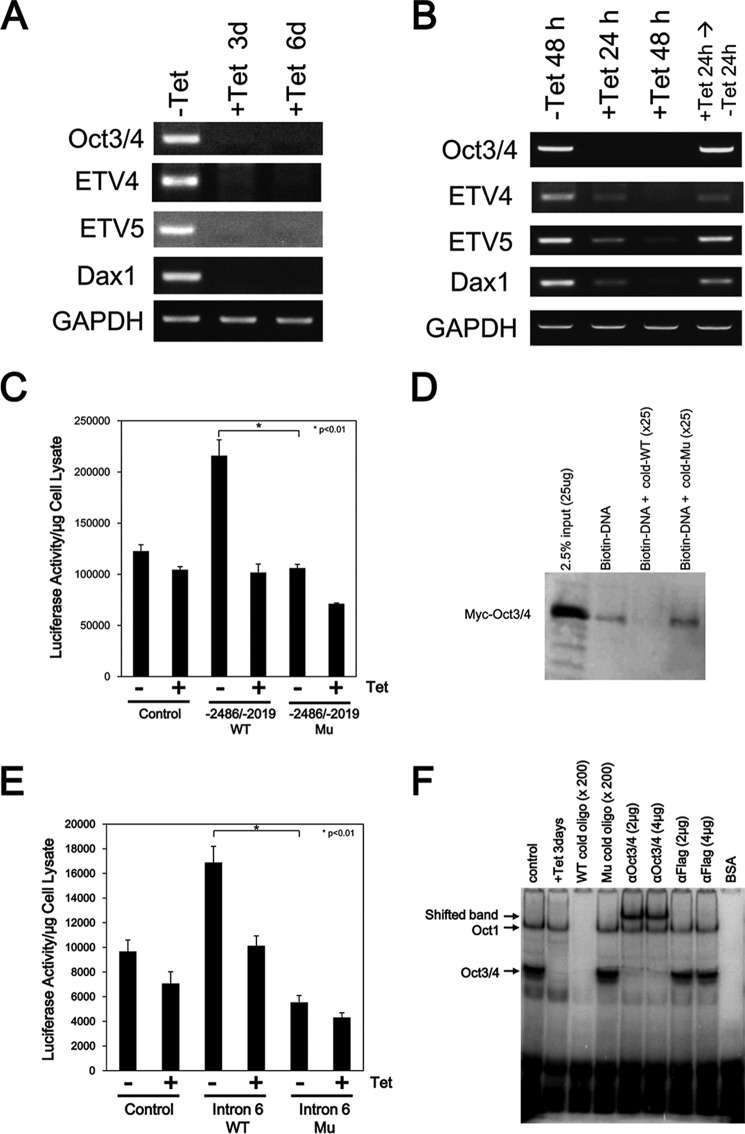FIGURE 1.
Expression of Etv4 and Etv5 mRNA in ZHBTc4 ES cells. A, reduction of Etv4 and Etv5 mRNA expression after repression of Oct3/4 expression. ZHBTc4 ES cells were cultured with or without 1 μg/ml Tet for 3 or 6 days. Expression of the indicated genes was examined by RT-PCR. B, induction of Etv4 and Etv5 mRNA expression by Oct3/4 expression. ZHBTc4 ES cells were cultured with or without 1 μg/ml Tet for 24–48 h. To restore Oct3/4 expression, the culture medium of Tet-treated cells was changed to a Tet-free medium, and the cells were cultured for another 24 h. Dax1 was used for a positive control as an OCT3/4 target gene. Gapdh was used as an internal control. All results are representative of three independent experiments. C, determination of an OCT3/4-responsive element in the Etv4 gene by a luciferase assay. The promoter region of the Etv4 gene contains a consensus sequence for an OCT3/4 binding site (ATTTGCAT). ZHBTc4 ES cells were transfected with either pGL4-promoter (control), pGL4-promoter-Etv4 (−2486/−2019)-wild type (−2486/−2019 WT), or pGL4-promoter-Etv4 (−2486/−2019)-mutant (−2486/−2019 Mu). ZHBTc4 ES cells were divided into two dishes 24 h after transfection and cultured with (+) or without (−) 1 μg/ml Tet for 24 h, and luciferase activity was measured. The sequence of the OCT3/4-responsive element was changed from ATTTGCAT to GACGTGGG. Shown are means (bars) and S.D. (error bars) of triplicate assays. D, OCT3/4 directly binds to the putative binding sequences. The association of DNA and OCT3/4 was examined by a biotin-labeled DNA pull-down assay. Biotin-labeled oligonucleotide containing the putative binding site was incubated with cell extracts from Myc-Oct3/4-transfected HEK293 cells either with or without 25-fold non-labeled WT or mutated (Mu) oligonucleotide. The result shown is representative of three separate experiments. E, determination of an OCT3/4-responsive element in the Etv5 gene by a luciferase assay. The intron 6 region of the Etv5 gene contains the consensus sequence of an OCT3/4 binding site (ATGCAAAT). ZHBTc4 ES cells were transfected with either pGL4-promoter (control), pGL4-promoter-Etv5 intron 6-wild type (Intron 6 WT), or pGL4-promoter-ETV5 intron 6-mutant (Intron 6 Mu). ZHBTc4 ES cells were divided into two dishes 24 h after transfection and cultured with (+) or without (−) 1 μg/ml Tet for 24 h, and luciferase activity was measured. The sequence of the OCT3/4-responsive element was changed from ATGCAAAT to GTGCCGCT. Shown are the means (bars) and S.D. (error bars) of triplicate assays. F, OCT3/4 directly binds to the putative binding sequences. An association of DNA and OCT3/4 was examined by an EMSA. Radiolabeled oligonucleotide containing the putative binding site was incubated with nuclear extracts from ZHBTc4 ES cells either with or without 200-fold cold WT or cold mutated (Mu) oligonucleotides, an anti-OCT3/4 antibody, or an anti-FLAG antibody. The result shown is representative of three separate experiments. Note that a band of OCT1-DNA complex can be detected in this assay as described before (66).

